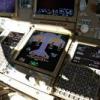
Search the Community
Showing results for tags 'guide'.
Found 13 results
-
The introduction of frame generation (FG) has been a game-changer for many RTX40-series owners. However, the AI-tech behind FG is not infallible. FG-related artifacts are an inherent problem with the frame generation AI technology (DLSS3) but can be avoided. The AI-tech behind FG basically inserts an AI-generated image in between two native images: The problem is that the AI tech sometimes fails to render the AI-image properly (causing artifacts). Factors that increase the chance of seeing these artifacts: native FPS is too low - I find that at least 30 non-FG FPS is needed for FG to work properly very fast panning very fast-moving objects very fast-moving numbers e.g. on speed-tapes I rarely see these artifacts. In fact the last time I can remember seeing them was on the dev mode FPS overlay where the numbers were changing extremely quickly: For some in-depth information about how FG works, and how it sometimes can create artifacts, I highly recommend this detailed analysis (they also talk about MSFS): https://youtu.be/92ZqYaPXxas?si=nk5bLaJPzUvg6gH4 Some examples of fast-moving objects where the AI tech fails to render accurate AI-frames (perhaps more relevant to more fast-paced games): Clearly, some people are much more sensitive to these artifacts than others. I've made many videos lately, and honestly haven't seen much of these artifacts, if at all. When considering getting a RTX40-series card, I highly recommend pairing it with a decent CPU. I have a 12900KF which IMO is working fine. Another thing: A 4090 is not needed unless you want the absolute best (and can afford it). Perhaps the biggest advantage with a 4090 is 24GB of VRAM. I've seen total VRAM usage up to 23GB. But that's an extreme example, usually it's much lower than that. In one of the most demanding locations in the sim, VRAM was about 15-16GB: I've been flight simming for more than 25 years. I've custom-built PC's for just as long. Performance has always been a problem. The most game-changing upgrade I've ever done was getting the 4090. Comments? Is it worth getting a RTX40-series card? Are people distracted by the artifacts? Hopefully this thread will generate some discussion as FG seems to be a very hot topic.
- 50 replies
-
- 13
-

-

-
- msfs
- frame generation
-
(and 1 more)
Tagged with:
-
Greetings fellow simmers! There's no lack of discussion and opinions on how to improve stuff to get stellar performance in MSFS. Heck, I've been guilty of that too many times on this forum. I'd like to think that most of us to some extent are chasing that ever-elusive Holy Grail: excellent performance combined with excellent image quality. I'd also like to hope that not too many poor souls find themselves as deep down the rabbit hole as I do. Believe me, that hole goes very deep. A tell-tale sign of this chronic, deteriorating affliction is tampering with Nvidia profile inspector, registry editor, NDU and SysMain. Maybe I should have taken the blue pill? Contrary to my previous topic, I wanted to take the opportunity to try to wreck havoc on performance in order to identify where the worst bottlenecks can be found. Inspired by a fellow captain (who pleaded the 5th and begged me to maintain anonymity), I booted up the latest beta build at KJFK and threw the following at the poor sim: Inibuilds KJFK Fenix A320 V2 (as we all know the modelling of cockpit door opening makes it way more performance-heavy than PMDG 737) FSLTL AI Traffic (base and injector) AIG models, flight plans and injector (AIGTC) GSX Pro REX AccuSeason REX Airport Textures We Love VFR by PUF GAIST Ultra v4.0 with North American Caribbean routes enabled Seafront vessels core (I would have thrown in Samscene3D's New York City Times as well, but didn't feel like cashing out on it) It's worth noting that most of these apps will not treat the mainthread very gently. Well, that's an understatement, as we shall see. These addons don't enter the sim with silk gloves on. They come armed with sledgehammers. Sim settings: 5461x2880 || DLSS ultra quality || FG || DX12 || PG || Shadows 6144 || real weather + other settings ultra/max (except for glass cockpit refresh rate medium) I used AutoFPS in a desperate attempt to avoid my rig going down in flames. Situation: Fenix parked at gate, panel status ready, drone mode, no panning. FSLTL off: FSLTL on: AIGTC on at 100%: Without FSLTL: avg fps 71.9 smooth 100% FTV <2ms 99.2% With FSLTL: avg fps 70 smooth 100% FTV <2ms 92.53% With AIGTC: avg fps 50.9 smooth 99.8% FTV <2ms 65.11% There's a caveat here, and that is that this comparison doesn't do AIG much justice. I had fairly moderate FSLTL settings, besides at the time it was RW night-time in NY (I set MSFS time to noon though), and FSLTL uses "live" flight plans, vs AIG's offline. Also, to show how much of a heavy hitter max AI traffic can be, I chose to add AIG into the mix as it's easier to just set 100% traffic vs. FSLTL's more elaborate settings. In this pitiful scenario, there's simply no overhead left as the poor mainthread is working overtime. The 4090 won't save the day heroically in this case (which it normally tends to do - otherwise no one in their right mind would spend their hard-earned cash on it). Reset's brilliant app does it's absolute best but falls short as well. No hate whatsoever towards AutoFPS - it's absolutely brilliant and I use it with every flight. Otherwise my 12900KF would have melted long ago with my ridiculously high settings (which I would never have been able to use without AutoFPS). In case anyone was wondering: FG won't save the day either. In fact it'll make it worse. Like a blizzard-combined-with-11058G70KT-standing-at-BIRK's-tarmac-in-December-worse. Explanation will follow. With a still drone view above the airport, with most of the main terminals in view (packed with AI aircraft on the ground as well as in the sky, as far as the eye can see), the mainthread is red-glowing at 44ms (!), native fps 22 (!!) and FG-fps 45. I'm pretty sure I could both hear and smell the agony of the 12900's P-cores. Some brave ones were in fact coming dangerously close to TjMAX at 100 degrees celcius. Panning around makes things worse. Much worse in fact. It's what we would call a real stutter-fest. A real word-not-allowed-storm. The worst enemy of any Serious Simmer™. Not only does low native fps facilitate a catastrophically bad simming experience, but FG actually adds fuel to the fire. Nvidia recommends native 60 and above fps for optimal results. Here we've got feeble 22 native fps. This is an excellent example of the appearance of the dreaded FG-related flickering (which I like to call FG-inherent artifacts), and it's quite distracting. Well, distracting is an understatement. So we find ourselves in the perfect storm: absolutely horrendous stuttering-galore combined with FG-induced flickering-artifacts. The 4090 basically meets it's greatest nemesis in this scenario: a wrecked mainthread which is completely overworked, overwhelmed (and probably underpaid!). Perhaps the much praised 7800X3D would have saved the day? I might be going out on a limb here, but I'd venture to guess it wouldn't have. I challenge 7800X3D + 4090 owners to prove me wrong. Could we make it even worse? Well we could increase TLOD to 600 and OLOD to 1000 (it's possible, I've tried). But there's really no point in doing so, as we don't want to throw our Xbox controllers at our overpriced OLED panels. Well, that's it for now. Comments? Can we make it worse? Do we really want to? Is FSLabs better than Fenix? May the Force be with you all. Please don’t bother to get up, I’ll show myself out. Cpt signing off.
- 162 replies
-
- 11
-

-
- terrible performance
- how-to
-
(and 3 more)
Tagged with:
-
Hi everyone. I've seen all the great scenery that MisterX6 and ISDG have produced, like KLAX and YSSY respectively, and I wanted to make my own contribution to the X-Plane community, by modelling WSSS (Singapore Changi) and hopefully other airbases around Singapore as well. Besides just the airports themselves, I'd like to populate the entire island and especially the Marina Bay area with nice, hand-made skyscrapers and multi-storey housing. I realise that this is a pretty big project, but I'd like to start small, with just the airport and underlying terrain textures around Singapore. Can I have a few guiding steps to get this kick-started? How do I change the farmland that currently covers most of Singapore into grass (this tiny island has no space for farming)? Also, WED is a little daunting. I suppose for maximum realism I will have to custom-model the buildings of Changi.
-
Hi everyone, I looked over the internet for a full detailed 777 FMC guide or tutorial, found nothing but 737 FMC guide (pdf). As we all know, the FMC is the brain of the airplane and when you understand it, you understand almost 70% of your bird. Yes we can fly the 777 anywhere by knowing the basics of the FMC. But still. Thanks a lot.
-
Here’s a quick guide explaining how to run GSX and PMDG’s ground vehicles side by side with all its glory, quirks and limitations. This will give you GSX’ fully animated ULD/pallet and catering loading, including realistic vehicle and container logos based on airline/airport, while retaining PMDG’s additional vehicles like cabin services, maintenance van and any extra cargo loaders which won’t be possible when running GSX exclusively as it still only supports a maximum of two catering trucks and two cargo loaders. This will see the Queen being surrounded by an appropriate number of servants, exactly how it should be ;) First things first: Update GSX to the most recent major version (1.9.9.11 or newer) as this will prevent GSX from removing any PMDG ground vehicles and it adds the PMDG 747v3 to its internal database to provide some basic compatibility. Put my customized GSX Aircraft files into the respective folder as per included readme.txt. More details at the bottom of this post. Although the most recent GSX update adds the PMDG 747 variants to its internal database, galley services (catering) are still being done through doors 1R and 5R, which isn’t very realistic on a B744 as there’s usually no galley in the tail section. I customized the GSX profile to ensure catering is being loaded through 1R and 2R. The AFT galleys will actually be supplied through door 4L on the opposite side. This door will still be serviced by a PMDG vehicle as GSX doesn’t allow more than two catering trucks. I also disabled door 5L to prevent GSX to place stairs at this door, as PMDG uses 5L for the cabin services truck (cleaners). Please note that this only hides the door for GSX, it will still be fully functional in the sim. I also disabled door checks for 1L in case of single jetway boarding. Also, please be aware that the aircraft diagram in the GSX -> Customize Aircraft menu won’t reflect the changes visually, its just a static image, so it will still show the 2nd catering door as being at the back. Just ignore this, the coordinates and open/close checks are set for Door 2R. Now we just need to hide some of the PDMG vehicles as they will be replaced by their GSX counterparts: Go to the FMC menu -> PMDG SETUP -> SIMULATION -> Page 10/10 and set the following: GROUND SERVICE OBJECTS = SHOW SELECTED GROUND SERVICE OBJECTS -> SELECT TO SHOW Then hide the following objects: FWD GALLEY MID GALLEY FWD CARGO AFT CARGO STAIRS 1L* STAIRS 2L* STAIRS 5L (* if parking stand has a jetway) Note: You could also hide the PMDG fuel truck and use the GSX truck instead. This will give you the choice between GSX traditional tanker-truck and PMDGs more modern, large airport hydrant-dispenser-truck. However, there’s a catch when using the GSX truck with AUTO GROUND OPS, which I will explain further below Now after everything is set up, let’s look into the actual turnaround process. You can either go for manual ground ops which gives you full manual control over timings for PMDG ground vehicles and door handling or you opt for AUTO GROUND OPS for realistic turnaround sequencing with little flexibility. In order to activate AUTO GROUND OPS just hit LSK3 on the GROUND OPERATIONS page to cycle through the available turnaround lengths (short, long and custom). For this guide I use the short turnaround time of 60 minutes. For a single leg flight or first flight of the day (no de-boarding): First check your fuel load. A 747 will usually have more than 30’000lbs (~16’000 kgs) remaining fuel, as landing with anything below can cause the fuel pumps to overheat. However, for most long haul flights, the airplane will be pre-fueled already before the turnaround starts, close to the actual plan fuel. Once dispatch has calculated the final fuel numbers, the refueler will just add the remaining amount to match the OFP numbers. As AUTO GROUND OPS uses realistic fuel flow values, it’s important to ensure that refueling doesn’t take too long (incl hook up time) as you might run out of time on a 1 hour turnaround, this will be indicated by a warning message on the FMC. If in doubt just make sure you add enough fuel before starting the turnaround timer. Now start AUTO GROUND OPS by selecting a turnaround time with LSK3 key, this should start the countdown timer. I won’t be going too much into detail about the timing, just play around and get a feeling for it. If you want more details about typical and realistic 747 turnaround timing, please refer to the official 747 Airport Planning document from Boeing. The timings PMDG used for auto ground services appear to be identical to the timeline diagram shown in this document. (Chapter 5.0 Terminal Servicing / PDF Page 120 or Document page 114) http://www.boeing.com/assets/pdf/commercial/airports/acaps/747_4.pdf BTW; the document mentions a boarding rate of 25 PAX per minute and 40 PAX per minute for de-boarding. Make sure you adjust your GSX settings accordingly After 4 minutes, Doors R1 and R2 will open which will start the catering resupply. Make sure you call GSX’ catering early enough to ensure that the trucks are in position when the doors are opening at T-4min. Note about GSX fueling: Should you opt to use GSX progressive, simulated fueling, you need to be aware that you won’t be able to start catering before fueling has been completed due to a GSX limitation. This could throw the entire timing off, that’s why I suggest to use PMDG refueling as this will allow you start boarding while refueling is still ongoing, just make sure you keep that fasten seatbelt sign off until refueling is completed to comply with real world procedures. The rest of the turnaround sequence is more or less self-explanatory. Keep in mind that you can override door control, so you can close certain doors earlier than AUTO GROUND OPS would normally do. For a multi-leg flight: I advise to complete GSX de-boarding phase before you start a new turnaround timer, otherwise AUTO GROUND OPS will start catering before de-boarding is completed. Not a big deal if you don’t mind open doors without anything attached to it ;) Once de-boarding is completed just follow the single leg procedure outlined above. Free tip of the day (especially interesting for the freight-dogs among us): By default, GSX will use the ground handlers logo for the cargo ULDs. On airports with dedicated (non-airline) ground handling this looks a bit strange as you might load Lufthansa ULD’s at departure and unload Menzies ULD’s at your destination. If you add the following line to the respective livery section of your aircraft.cfg, GSX will always use the airline logo for containers (or whatever valid 3 letter ICAO code you put in) atc_parkingcodes=XXX (replace XXX with the 3 letter ICAO code of your airline) So lets say you add ‘CPA’ as parkingcode for your Cathay Pacific livery and park your plane at VHHH, this would give you ground handling by ‘Hongkong Airport Services’ (HAS), catering by ‘Cathay Pacific Catering’ and the containers will bear the Cathay Pacific logo, just as in real life. I might be doing a quick time-lapse video showing a 60 min turnaround using both types of vehicles. Hope I’ll be able to complete it sometime this weekend. Note: I’ve attached two GSX aircraft config files, one for the 747-400 and one for the 747-400F. The PAX version will have the 2nd catering truck moved to door R2 (from R5) as described above and the freighter version will enable the main/side cargo door for GSX Hi-Loader including proper door checks for. This means that FWD cargo and Side/Main cargo will be served by GSX while AFT cargo is being done by PDMG vehicle. Make sure you change the show/hide config in your FMC accordingly. Download GSX configs I’ll add config files for all the other variants later.
- 28 replies
-
- 16
-

-

-
I know some people have this running under Linux with Wine, could I get a little help here. Seems my outerra spits couple errors, I run Linux Mint 17.1 XFCE with latest Nvidia drivers (980GTX) and get these errors before application fails and closes down. 1) Unable to find Nvidia driver version number. Please update you graphics card drivers,...... 2) Error initializing OpenGL subsystem. This program requires OpenGL 3.3 capable graphics card with recent drivers. No suitable pixel format found. If by miracle someone is able to help me, cheers
-
Hello! I need help on how to start MCE in fsx.... I dont know how, and I have read the guide, and it doesnt help me... someone please help! I really want to use this product! (Btw, I have the aerosoft airbus X extended, if that could help with anything) Thanks
- 2 replies
-
- mce
- multi crew experience
- (and 6 more)
-
Hi Folks... Was wondering if there is an official guide to "FTX Central version 2" that relates to library insertion points... Thanks... Flyboy 53
-
this is by no means a jab at folks struggling with the 320, I am still learning more about it daily and its a joy to fly. Here is a very shallow guide on how I go about not crashing the 320 neo, its default so it should cover all bases minus a few extra clicks in the modded version. Also, please realize being a casual guide, it will clearly not follow real world operations, its more so to stabilize a few folks having issues with using the bird and allow them to learn more in depth once they get the grips of it all.
-
I've taken over Paul "PJ" Johnson's excellent "How-to" guide for new DX10 Fixer Users. His original document helped me get my system set up correctly. It's a step-by-step guide and (I think) quite comprehensive - no need to look up other sources. Used with Steve's manual, I'd say it's all you need. The REVISED "How-to" Guide (v1.01 01 July 2014) For related DX10 files: DX10 Fixer - all related files All feedback welcome - here or by PM. Adamski.
- 6 replies
-
- how-to
- dx10 fixer
-
(and 1 more)
Tagged with:
-
Over the past few weeks (and months), there have been numerous threads and posts regarding calculating performance figures in the PMDG 777-200LR/F, especially takeoff figures including assumed temperatures and V-Speeds. In those threads that I participated in, I mentioned the use of numerous manuals, such as the FCOM and FPPM to gain some figures for take-off performance. This will be a guide on how to do so, particularly for the 777-300ER fitted with GE90-115B’s.I would like to stress that while this is for the 300ER, assuming you have the appropriate manuals for the 200LR, the same method can be used. While I tried to use the FCOM as much as possible, some things are just not available in Volume 1 and therefore I was forced to use the FPPM. First of all, before I start, I would like to make a note that is not how a real crew would calculate/obtain their takeoff performance. They would either use performance manuals created by the airline, which are airport and runway specific, or OPT software on the Boeing fitted EFB or on a small ‘e-laptop’ (10” screen netbook etc.). You will see throughout the guide that a lot of rounding/conserving occurs, therefore there would be some discrepancies compared to if you used OPT software. Some acronyms used throughout this guide are; FPPM – Flight Planning and Performance Manual FCOM – Flight Crew Operating Manual (and for the purposes of this guide, solely Volume 1) OPT – Onboard Performance Tool ATM – Assumed Temperature Method V Speeds – V1, VR, V2 RW – Runway TORA – Take Off Runway Available ETOW – Estimated Take Off Weight I would also like to add, that this is a very primitive way of gaining figures from the FPPM/FCOM. Really, if I was flying a real T7, and only had access to the FCOM or FPPM, and none of the tools I mentioned above, I would go through 5 different charts/tables which contain numerous considerations (Runway Slope, Obstacles, Tire Limits, Brake Energy Limits etc.). For the purpose of this exercise, I will only be using the figures from the Takeoff Field Limit chart and tables. For the purposes on a flight on FSX, this suffices fine IMO. In real life, the performance manuals provided by the airline take into consideration all these things, and therefore the time taken to come up with an assumed temperature and v-speed is considerably quicker than doing so through the FCOM and FPPM. Now, lets get started! First of all, the scenario that I will be using.Today, we are flying a 777-300ER, fitted with GE90-115B’s, out of Sydney (YSSY), with a planned departure of Runway 34L. RW34L, from intersection A6, has a TORA of 3900m (3962m to be exact). For weather purposes, we will assume there is a direct 10kt headwind (so METAR is reporting 335/10), and the runway condition is dry. Our company SOP’s call for a FLAP15 departure with a D-TO1 de-rate setting. The pressure altitude at Sydney is rounded to SLP (0ft). Our ETOW today is 312450 KG’s(312.4T). Now to calculate our figures; Step 1: The first step to complete is to get our compensated TOW which will take into account the 10% decrease in available thrust due to our selection of a D-TO1 de-rate setting. To do that, we go the FPPM. We are working backwards with this table, as with most tables/graphs in the manual. Now in the table, as you can see there is no exact match for our TOW (312.4t). With all these charts, you are taught to be conservative. So for our purposes, we are going to use the figures for a TOW of 314.7t. So looking at the table above, you can see that with a TO1 de-rate setting, with a TOW of 312.4t (conserved up to 314.7t for planning purposes), the TOW that we should plan our figures for is now an amended 340t. This is due to the fact that we will have 10% less thrust available on the take-off roll. N.B: If the airline dictates that D-TO2 is also available, there are similar charts in the FPPM which provide figures for 25% thrust decrease availability. Step 2: It’s now time to find our corrected runway length to take into considering wind component and slope. Now as FSX’s runways aren’t sloped, I won’t be doing any calculations related to the slope. However, I will do so for wind component. The headwind component on RW34L is 10kts. The TORA from A6 sourced from ERSA is 3900m. We now can go to the FCOM and pull out the ‘Field Corrections’ chart. We are once again going to be conservative and choose a shorter runway length then we actually have. In this case I have chosen 3800m. Going horizontally across from my runway length and vertically down from my headwind component, you can see that we arrive at a figure of 3950m. Due to the headwind component, we have virtually obtained another 150m of available takeoff runway. Step 3: It’s now time to find our assumed temperature. For that we have 2 sources. We can either use nice, pretty and easy tables in the FCOM, or a nice graph that we can plot on from the FPPM. For the purposes of this tutorial, I will be using the tables from the FCOM (as most people don’t have access to the FPPM). Once again, we start at our corrected runway length (which has been conserved back down to 3800m from 3950m), work horizontally across till we find our TOW (which has been conserved up to 341.6t from 340t), and go horizontally up to find our max OAT. Therefore today, our assumed temperature, with a D-TO1 rating will be 42°C. Step 4: Time to get those important V-Speeds! Luckily, in the FPPM, we have a table to find our V-Speeds for D-TO1 take-off. Let’s pull out the V-Speed charts, for a dry runway with a D-TO1 rating. Now, since this chart is taking into considering the 10% thrust reduction, we DO NOT use our amended TOW which was calculated in Step 1. With our ETOW being 312.4t, I have rounded it up to 320t. Going horizontally across from 320t, and vertically down from Flaps 15, we arrive at our V-Speeds. V1 = 156, VR = 170 ad V2= 176. However, since we have a 10kt headwind, we must account for that such wind. Therefore we must now pull out the ‘Wind V1 Adjustments’ table. Once again, going horizontally across from 320t, and vertically down from our headwind component of 10kt, a V1 correction of 1kt needs to be accounted for (Yeah, I know, not much!). Therefore our takeoff performance looks something like this; --------------------------------------------- YSSY 34L @ A6, 3960m TORA D-T01, 42C N1: 96.8% V1: 157 VR: 170 V2: 176 ---------------------------------------------- Step 6: Enter all the relevant data into the FMC. De-rate and assumed temperature is done through the THRUST LIM page, and the V-Speeds done through the TAKEOFF REF page. I hope this guide helps some of you when the T7 comes out, and helps you get some rough performance figures until either TOPCAT or another 3rd party developer (Aurasim etc.) is able to produce a 777 takeoff performance tool. Any questions please ask away!
- 63 replies
-
- 22
-

-
AVSIM is an enduring institution in the virtual aviation world providing a dependable and consistent platform to exchange knowledge and ideas. Over the years many of the leading flight simulation software and hardware gurus have graced these forums, gathering and honing their skills while dramatically increasing the quality of our hobby. Although a few names may stand out above others, the list of unique contributors is long and varied and we thank them one and all. Paul Johnson has put together the AVSIM Software and Hardware Guide for both the DX9 and DX10 versions of FSX. It incorporates the latest and best techniques and the tried and true standbys into detailed instructions on what to do and how to do it. Paul will periodically update the guide as needed on a regular basis as new information, equipment and methods evolve. We hope that you will benefit from the accumulated wealth of knowledge presented here. Here it is: http://forum.avsim.net/files/file/1-fsx-hardware-software-guide/ Note: Latest version of Adobe Reader REQUIRED This post has been promoted to an article
-

A few hints at a good approach and landing
Andreas Stangenes posted a topic in MS FSX | FSX-SE Forum
Hi there fellow simmers. I made a few vatsim and fsinn tutorials earlier, and they became somewhat popular. I decided to make a lil' something for the fresh simmers among us (if they exist? ). In this video I talk about how to maintain stability during approach, and some tips to where to fix your eyes just before and during the flare. I also show how you can use the external views to aid you in working on your techniques. Disclaimer: I am not saying I'm professional at this. I'm a hobby flightsim enthusiast, and please treat this guide as such. http://www.youtube.com/watch?v=XC-ASLTsaRE&feature=youtu.be Happy landings!









